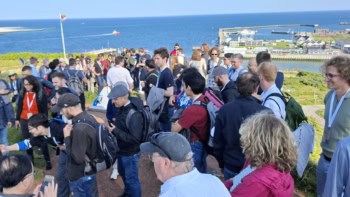Physics is a diverse subject that should in principle be open to all types of people from all types of background. In reality, however, there are often biases – be they conscious or unconscious – that can prevent access and stifle career progression based on irrelevant factors such as gender, race or physical ability. While these issues require cultural and organisational change, we believe that quality journalism can add to the debate and influence the direction of travel. We can contribute to this by profiling the many faces of physics – in terms of the diversity of science and the diversity of people involved. Within our journalist toolkit, podcasts and videos can tell compelling stories from the world of physics in personal and engaging ways. Here is a selection of some of the audio and visual highlights from Physics World in 2016.
Transforming light
In January, we published the final instalment from our “Light in Our Lives” series, which we commissioned as an official media partner with the Internal Year of Light (IYL 2015). Each film in the series told a local story involving light and its applications and how they can affect people’s lives. Transforming Light is a film about the 2015 Day of the Dead celebrations in Mexico City and how a multimedia lightshow blended old traditions with new technologies to spectacular effect. The film was produced by Jorge Benjamín Ruiz Gutiérrez and his team of film-makers at the National Autonomous University of Mexico (UNAM).
Faces of physics
Following on from the Light in Our Lives series, we decided to commission another film series for 2016 – this time related to diversity within physics. “Faces of Physics” reveals the working lives of people involved in physics, focusing on the day-to-day activities as much as the applications of their work. Inspiring the Next Generation (above) offers a profile of Ghada Nehmeh, a physics teacher who has brought about innovative changes at the Bronx High School of Science in New York. By creating an interactive environment in her classroom, Nehmeh has significantly boosted the number of female students taking Advanced Placement (AP) physics.
The other films published in this series to date are: Working in Green Energy about renewable energy engineer Samantha Carter; and A HAWC Eye on the Sky about Adiv González Muñoz – an astronomer and timelapse photographer at High-Altitude Water Cherenkov (HAWC) gamma-ray observatory in Mexico. For more stories and analysis about diversity issues in physics take a look at the March special issue of Physics World, which is introduced in this blog post by Physics World editor Matin Durrani.
Bringing Native American voices back to life
I mentioned at the start of this article that physics is a diverse subject spanning a range of areas. A good example of this was the July episode of the Physics World podcast, which brought together the unlikely mix of particle physics, Native American storytelling and the evolution of audio recording media. “Bringing Native American voices back to life” profiled a project to restore early 20th century recordings of Native Americans performing songs and stories. The method, based on imaging technologies at particle accelerators, has been developed by Carl Haber of the Lawrence Berkeley National Laboratory (LBNL). Listen to the podcast to hear rare recordings of myths told by Ishi – the last surviving member of the Yahi people of the central Sierra Nevada mountain range in northern California.
Still not even wrong
Theoretical physics can seem abstract at times and about as far removed from everyday life as one could imagine. But it is also an intellectual pursuit like any other, carried out by people with personalities, opinions and beliefs – people who don’t always agree with each other. The sociological dimensions of theoretical physics were particularly apparent in the so-called “string wars” – a vitriolic debate played out in the 2000s about the scientific validity of string theory. A key player in the string wars was mathematical physicist Peter Woit whose 2006 book Not Even Wrong took string theory’s supposed inadequacies to task. In the September podcast, Peter Woit is in conversation with Physics World reporter Tushna Commissariat 10 years since the book’s release. Woit speaks about controversy sparked by his book and what he thinks needs to happen now in mathematical physics to propel it into the future.
Doing physics by ear
If the complex mathematics of physics is hard to get your head around sometimes, then imagine trying to do it without the ability to see the equations. That is the reality for Aqil Sajjad, a particle physicist at Harvard University in the US, who lost his sight to retina detachments in both eyes when he was a teenager in Pakistan. Sajjad tells his story in the November episode of the Physics World podcast produced by journalist Lucina Melesio. You will hear how Sajjad accesses maths and science concepts using speech-to-text software. When not pondering the nature of the universe, Sajjad is also a keen baseball player and often travels to other US cities with his team the Boston Renegades. Though – as Sajjad explains in the podcast – at heart he prefers cricket.
Physics on your phone
Finally, in this collection of stories celebrating the social aspects of physics, we’d like to draw your attention to the various short videos we’ve been producing for our social media channels. With the proliferation of smart phones and other mobile devices, we know that your viewing habits are changing and that you want to get your physics stories on the go. So we have been producing a number of short videos for our Facebook page, Twitter feed and YouTube channel. They can be enjoyed with or without sound. For instance, the video above provides a guide to NASA’s Juno mission, which arrived at Jupiter in July where it is now investigating this planet from orbit. One of the major scientific goals of the mission is to better understand the origins of this giant planet, providing key information about the origins of the entire Solar System.
Watch out for much more multimedia – including social videos – in 2017.



